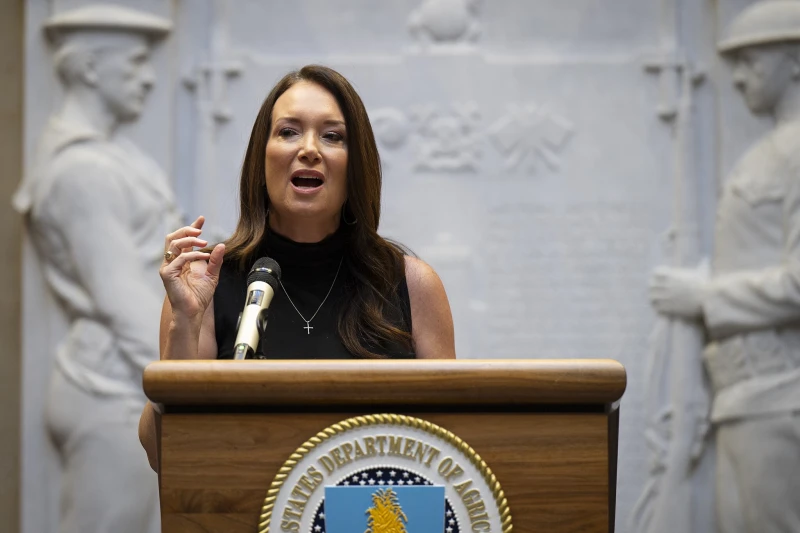

U.S. Agriculture Secretary Brooke Rollins hosts a USDA all-staff meeting on May 23, 2025, in Washington, D.C. Rollins announced the termination of household food insecurity reports in September 2025. / Credit: USDAgov, Public domain, via Wikimedia Commons
Washington, D.C. Newsroom, Oct 20, 2025 / 05:20 am (CNA).
The Trump administration’s recent decision to cease publishing an annual U.S. Department of Agriculture report on household food insecurity is being met with strong criticism by the Catholic Health Association of the United States, anti-hunger activists, and academics.
The last USDA food insecurity report, covering 2024 data, is set for release Oct. 22. On Sept. 20, the USDA, led by Secretary of Agriculture Brooke Rollins, who was appointed by President Donald Trump, announced the termination of future “Household Food Security Reports,” which were first published in 1995 during the administration of then-President Bill Clinton.
“These redundant, costly, politicized, and extraneous studies do nothing more than fearmonger,” the USDA said in a published statement.
The USDA questioned the legitimacy of the annual reports, saying food insecurity trends have remained virtually unchanged since 1995, “regardless of an over 87% increase in SNAP spending between 2019–2023.”
SNAP is an acronym for “Supplemental Nutrition Assistance Program,” which according to the USDA “provides food benefits to low-income families to enhance their grocery budget so they can afford the nutritious food essential to health and well-being.” SNAP was formerly known as the “Food Stamp Program.”
The Trump administration explained its decision for discontinuing the reports, saying: “For 30 years, this study — initially created by the Clinton administration as a means to support the increase of SNAP eligibility and benefit allotments — failed to present anything more than subjective, liberal fodder.”
Responses to terminating the report
“I don’t think collecting data about food insecurity across the country is ‘liberal fodder,’” said Lisa Smith, vice president of advocacy and public policy for the Catholic Health Association of the United States, which generally aligns with Church teaching but has clashed with the U.S. bishops in the past on health care issues, such as the Affordable Care Act. “When you don’t have the data, it makes it more difficult to know where the keys areas of need are.”
The end of the annual food security report “is going to impact the health of low-income communities,” Smith said. Smith’s concerns were echoed by Colleen Heflin, a professor of public administration and international affairs at Syracuse University and co-author of “Food for Thought: Understanding Older Adult Food Insecurity,” a book published last month along with Madonna Harrington Meyer, a sociology professor at Syracuse.
“Without national data from the Current Population Survey on food insecurity, it will no longer be possible to track year-to-year variation in food insecurity due to changing economic and policy conditions,” Heflin said. “This lack of data will make it harder for Catholic charities and other community-based organizations to effectively address food insecurity without a consistent and comprehensive understanding of how food insecurity is changing for different demographic and geographic communities.”
Like Smith, Heflin dismissed the Trump administration’s claim that the reports were little more than liberal, redundant fearmongering.
“Food insecurity data collection has been a bipartisan issue since the Reagan administration,” since the 1980s, Heflin said. Referring to the Trump administration’s plan to end the annual report, Heflin said she found “both the decision and the justification provided quite shocking and without merit.”
James Ziliak, a professor of microeconomics and founding director of the Center for Poverty Research at the University of Kentucky, told CNA that eliminating the USDA household food security reports could reduce public and policy awareness of hunger needs and hinder private-sector responses, such as those by Catholic health and social service organizations.
“This report was one of the most widely watched barometers of economic well-being among low- and moderate-income households in the U.S. and provided key information for policymakers, charitable organizations, and researchers,” Ziliak said in an email.
Like Smith and Heflin, Ziliak said he did not accept the Trump administration’s explanation for ending publication of the annual report.
“This is absolutely not justified, and the timing is especially harmful to public policy as the economy slows down and major cuts are being implemented in the largest federal food assistance program,” he said, referring to SNAP.
Read More![Missouri court says man can sue St. Louis Archdiocese over abuse he repressed for decades #Catholic
The Cathedral Basilica of St. Louis. / Credit: legacy1995/Shutterstock
CNA Staff, Oct 16, 2025 / 11:48 am (CNA).
A Missouri appeals court has ordered that an alleged victim of clergy sexual abuse can sue the Archdiocese of St. Louis, ruling that an arcane aspect of bankruptcy law does not negate the archdiocese’s potential liability for abuse that the plaintiff allegedly repressed for decades.The case touches on both the complex character of U.S. bankruptcy statutes as well as the often-protracted nature of abuse allegations, which frequently only come to light years or decades after the abuse is alleged to have occurred. In its Oct. 14 ruling, the Missouri Court of Appeals, Eastern District, said the alleged victim, John Doe, claims to have been abused at the St. Joseph’s Home for Boys in the late 1980s. Doe alleges that Father Alexander Anderson, who was assigned as a counselor to the home, sexually abused him; the plaintiff said he “reported the abuse [but] no action was taken,” according to the court. Doe “alleged he repressed his memory of the abuse until 2016,” the court said. He ultimately filed suit against the archdiocese in August 2022. The archdiocese argued in response that Doe’s abuse claim was effectively negated by two bankruptcy claims he had filed in 2008 and 2009. U.S. law dictates that when debtors file for bankruptcy, they create “an estate that includes nearly all of the debtor’s legal or equitable interests in property,” including legal causes of action. The archdiocese claimed that since Doe did not list his abuse claims as “exempted assets” in his bankruptcy proceedings, they became part of that “estate” and can only be administered by the trustee that handled those proceedings. The appeals court rejected the archdiocese’s argument, reversing a lower court decision and holding that Doe’s “cause of action” only arose when he said he remembered the alleged abuse in 2016, “well after” his bankruptcy filings. Doe’s standing to sue “did not accrue [when] the sexual abuse was allegedly committed” but rather when it was “capable of ascertainment,” the court held. The court’s ruling cited Missouri Supreme Court precedent, which holds that, in some cases of abuse, “the victim may be so young, mentally incompetent, or otherwise innocent and lacking in understanding that the person could not reasonably have understood that substantial harm could have resulted from the wrong.”The St. Louis Archdiocese did not immediately respond to a request for comment on the ruling on Oct. 16. This is not the first instance in which the archdiocese has been held accountable for abuse allegations that an alleged victim claimed to have repressed for decades.In 2023 the archdiocese agreed to pay a $1 million settlement to a man who said he was abused by Father Gary Wolken in the mid-1990s but repressed the memories until he was an adult. Wolken was in prison from 2003 to 2015 for sexually abusing another boy in the St. Louis area from 1997 to 2000.](https://unitedyam.com/wp-content/uploads/2025/10/missouri-court-says-man-can-sue-st-louis-archdiocese-over-abuse-he-repressed-for-decades-catholic-the-cathedral-basilica-of-st-louis-credit-legacy1995-shutterstockcna-staff-oct-16-2025.webp)


















